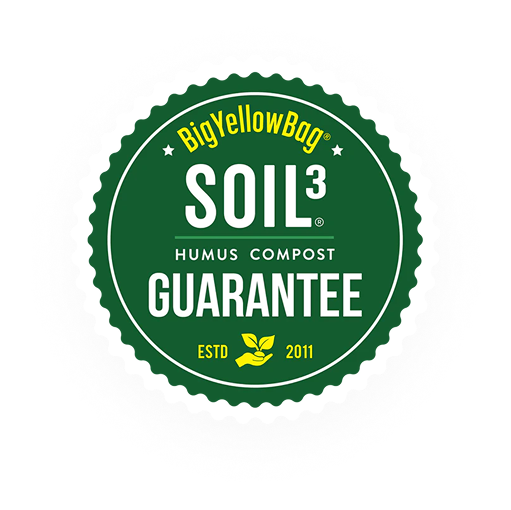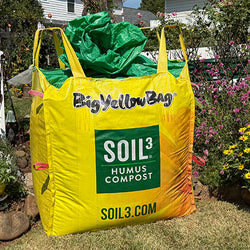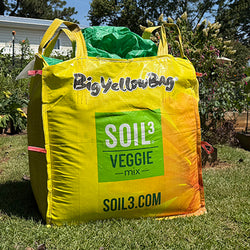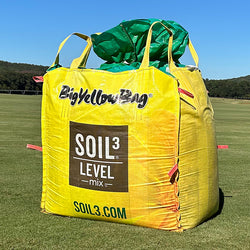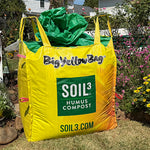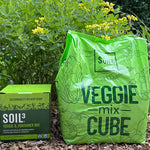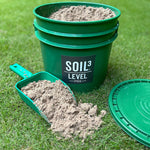FAQs
Humus compost is organic matter that has broken down into the smallest particle sizes so that it starts releasing nutrients. Read more info on this page: What is Humus Compost. Cooking Tip: Hummus is a delicious chickpea spread – our humus is organic matter that improves soils. Similar spelling, but don’t dip your chips in our humus.
Choose humus compost to improve all clay or sandy soils when laying sod, starting lawns from seed, and when planting all ornamental plants, including annual beds, perennial and shrub beds, and trees.
You can look up all rates and use the compost calculator on this page: Calculator & Rates
Our humus compost is made with three main ingredients: grass clippings, wheat stubble, and cow manure. Some sand enters the process from the gravel/sand pads where we make the compost.
No peat or sludge/biosolids are in our compost or any of our mixes.
No fillers such peanut hulls, vermiculite, perlite, bark, or peat is in our compost.
Our compost is made outside on sand and gravel pads so there is good drainage for the process of making the compost. Sand does enter our compost in this production process and actually helps, because sand improves the compost texture, adding air space. Air pockets and passageways are critical for root development. Without the sand, pure compost becomes heavy, wet, and clumpy because it binds to itself in balls. With the sand included the humus binds to the sand and becomes easy to shovel, easy to spread, and easy to plant in because it’s crumbly, like chocolate cake mix. We hope you take these advantages into consideration.
Our compost and mixes are not mulch and there is no mulch-like consistency; there are no large pieces of bark, wood, twigs, or sticks that comprise mulch. The purpose of mulch is to suppress weeds and to conserve soil moisture, so we always recommend mulching on top of our humus compost or Veggie Mix.
Compost is heavier than typical peat-based potting soils you may be accustomed to. The compost is heavier than peat, but it offers much more, and it’s normal for it to be heavy. There is usually no need to add anything else when amending native soil with compost. For certain plants, we recommend fertilizing or adjusting the pH based only on the feedback of a soil test after compost has been added to the native soil. Plants grown in compost-amended soil and will flourish with proper care! We recommend mulching your beds to conserve moisture and watering enough to keep the beds slightly moist.
Yes, you can use it! It's common for compost and organic matter to become dense as they break down under exposure to the elements. All you need to do it break up large chunks with a shovel and use it for gardening, even if there are still clumps. Once it's in contact with your native soil, exposed to water, and plant roots start to grow in it, it will settle in quicker than you'd think.
This is a little hard to explain – so hang in with us here! Our compost is organic matter that is OMRI Listed, meaning it is organic matter that's approved for certified organic gardening. Crop inputs such as compost are not designated as “USDA Organic” because that title is specifically for produce (fruits and vegetables) grown with organic practices. Organic farmers use OMRI Listed products to obtain their USDA Organic certification for their produce. That’s why we technically cannot call our compost “organic” and must specifically say it’s approved for organic gardening. When you're researching organic gardening products, look for the OMRI Listed logo on them, and you’ll know they’re safe for growing under organic practices. Here is more info about OMRI: What does OMRI listed mean?
You can download our OMRI certificate for our compost on this website: https://www.omri.org/mfg/psc
Veggie Mix contains 75% of our humus compost blended with 25% bark products, plus an added 2.5 lbs. of activated charcoal per cubic yard. The humus compost, the core product in the Veggie Mix, consists of three primary ingredients: grass clippings, wheat stubble, and cow manure, along with some sand from the dairy barn pads and the gravel/sand pads where we create the compost.
You can look up all rates and use the compost calculator on this page: Calculator & Rates
You can look up all rates and use the compost calculator on this page: Calculator & Rates
The addition of 25% bark products to our Soil³ compost improves drainage for containers and raised beds. Activated charcoal protects plants against persistent herbicides when growing any type of vegetable garden. We added these two products to make Veggie Mix the safe, rich growing medium of choice for all vegetable gardens and any type of plant in containers and raised beds.
Choose Veggie Mix for all vegetable gardens (in-ground, raised beds, grow bags) and for any type of plant in outdoor containers, window boxes, seasonal pots, deck and patio plants, as well as for dividing, potting up plants, and seed starting. Choose humus compost when laying sod, starting lawns from seed, and for planting all ornamental plants, including annual beds, perennial and shrub beds, and trees. We strongly recommend Veggie Mix as outlined above, but these are general guidelines and crossover use is reasonable at your own discretion.
No peat or biosolids are in Veggie Mix. It contains only our own compost as the core ingredient, plus bark products and activated charcoal.
Aged pine bark fines and EZ Blend HydraFiber.
EZ Blend
Our compost and mixes are not mulch and there is no mulch-like consistency. The bark in Veggie Mix is very small and is added to improve drainage; there are no large pieces of bark, wood, twigs, or sticks that comprise mulch. The purpose of mulch is to suppress weeds and to conserve soil moisture, so we always recommend mulching on top of our humus compost or Veggie Mix.
Veggie Mix is a compost-based product, which makes it heavier than the typical peat-based potting soils you may be accustomed to. The compost is heavier than peat, but it offers much more, and it’s normal for it to be heavy. There is no need to add anything to Veggie Mix unless you wish to; for instance, some people add perlite or more bark to lighten the load in tower gardens, hanging pots, or window boxes. When amending the ground or filling raised beds, there is no need to add any fillers or fertilizers. The 25% bark in Veggie Mix provides sufficient drainage, while the compost portion supplies the necessary nutrition. Plants grown in Veggie Mix and will flourish with proper care! We recommend mulching your beds to conserve moisture and watering enough to keep the beds and containers slightly moist.
Yes, you can use it! It's common for compost and organic matter to become dense as they break down under exposure to the elements. All you need to do it break up large chunks with a shovel and use it for gardening, even if there are still clumps. Once it's in contact with your native soil, exposed to water, and plant roots start to grow in it, it will settle in quicker than you'd imagine. If you want to fill trays for seed starting or pots for annuals/etc., fill them with Veggie Mix then water them in for a few days before you plant them.
It is as close to organic as you can possibly get, but it's not OMRI Listed. Please see details under the FAQ "Is the Veggie Mix OMRI Listed?"
No, but we are applying for OMRI Listed classification for Veggie Mix. Two of the ingredients in Veggie Mix are OMRI Listed: the primary one is our Soil³ compost, which makes up 75% of the mix, while the other ingredient is HydraFiber bark, comprising 12%. If you're growing vegetables, we highly recommend Veggie Mix due to the additional layer of protection provided by the activated charcoal. Here are links to the OMRI credentials for the compost and HydraFiber.
- Soil³ compost: https://www.omri.org/mfg/psc
- HydraFiber: https://www.omri.org/mfg/prp
Level Mix contains 70% golf course sand blended with 30% of the humus compost.
For topdressing lawns, choose Level Mix to smooth bumps and ridges, raise low spots and depressions, fill in divots and tire marks, and to generally smooth established warm season lawns during the growing season; choose humus compost when topdressing all warm season and cool season lawns to replace 1 fertilizer application by providing natural nutrition and friendly microorganisms while improving your soil from above. Further about Level Mix, it smooths and levels lawns to create a safe walking and playing surface and it levels high spots that are easily scalped when mowing. Leveling with Level Mix improves the aesthetics and safety of your lawn.
PGA approved silica sand with a medium particle size. It is not masonry or play box sand.
We cannot send a nutrient analysis for our all-natural compost and mixes because we aren't licensed to sell our products as fertilizer. Soil³ compost and mixes are not soluble, chemical-based fertilizer like traditional synthetic fertilizers, so the conversion is not the same. We can inform you that we conduct soil tests as part of our production standards, and Soil³ consistently maintains a pH of around 7 and is rich in nutrients. Try it and see! As long as you grow straight in or top off with Soil³ compost or Veggie Mix each year, you probably won’t need to spend money on fertilizer.
Our compost is fully decomposed and will not burn or otherwise harm plants. Please remember that traditional "soil tests" conducted through your state’s Agriculture Cooperative Extension office do not accurately reflect the nutrients present in compost. Since our compost is manure-based, a "manure/sludge,” “compost/manure,” or "potting medium" test provides a more accurate analysis than a "soil test," which is designed for structural soils (rock-based, including clay or sand). If you wish to perform an accurate nutrient test on compost, we recommend Waters Agricultural Lab for all potting mix and compost reports: https://watersag.com/service/manuresludge-analysis/
If you conducted a traditional “soil test” through your state’s Agriculture Cooperative Extension office, the pH and other nutrients might not be represented accurately. Since our compost is manure-based, a "manure/sludge,” “compost/manure,” or "potting medium" test provides a more accurate analysis than a "soil test," which is designed for structural soils (rock-based soils such as clay or sand). For an accurate pH test on compost, we recommend Waters Agricultural Lab for all potting mix and compost reports: https://watersag.com/service/manuresludge-analysis/. Once the compost is utilized in your garden, the general soil solution’s pH will stabilize to an optimal range for most vegetables, which is typically between 6.5 and 6.8.
The pH of compost, including ours, is naturally around neutral or 7. Hand-held meters and at-home kits are notoriously unreliable, even those of "professional" quality. If you’re curious about the pH of your compost, we recommend getting a lab pH test for "manure/sludge,” “compost/manure,” or "potting medium" (not a soil test, as compost is not soil). For an accurate pH test on compost, we recommend Waters Agricultural Lab for all potting mix and compost reports: https://watersag.com/service/manuresludge-analysis/.
Pro Tip: If your at-home kit or meter shows a pH of 4.5 or lower, the product would burn your skin if it were genuinely that low.
Veggie Mix contains fewer nutrients due to the addition of 25% bark, but in our growth trials, we don't see much of a growth difference and we still didn’t need to add any fertilizer for the same amount of produce harvested. The trick is to top off raised beds with fresh Veggie Mix when changing out crops (as the volume diminishes) and to discard the contents and refill with fresh Veggie Mix when changing out container plantings. For in-ground beds, simply top-dress with a 1-2” layer every time you replant.
In soil reports we run, there is plenty of calcium in Soil³ compost and Veggie Mix. Blossom end rot can appear in tomatoes and peppers that aren’t consistently watered, even when there is an ample amount of calcium in the soil. If the soil dries out, that’s when problems occur because calcium is not very mobile in plants. Once calcium uptake is disrupted, it’s hard for plants to recover, but they will. There are two solutions: 1) Spray foliar calcium, 2) Patience – keep soil consistently moist, and tomatoes later in the season will not experience BER. During high heat or drought conditions, please water your tomatoes every day or every other day if they are grown in the ground and every day in containers - ample watering will prevent BER. People grow tons of tomatoes in Soil³ without needing additional fertilizers and without BER appearing. Mulching also helps conserve moisture.
No need to apply fertilizer, especially when using fresh Soil³ compost or Veggie Mix; both products have enough nutrients to grow healthy vegetables and ornamentals (flowers, shrubs, and trees). Just be sure to water regularly, especially tomatoes and peppers, as they require consistent moisture to properly absorb nutrients (such as calcium). Refill beds and containers, and topdress in-ground beds with more compost or Veggie Mix each year to keep it fresh. If you use synthetic or too much of any fertilizer with our compost or Veggie Mix, it may adversely affect the microorganisms and even possibly increase the risk of burning your plants.
Reuse it: Customers often keep empty BigYellowBags and repurpose them. Some ideas are to collect hard waste and debris, fill with lawn clippings or leaves before adding to a compost pile, cover outdoor plants on frosty nights . . . Get creative!
Return it: Customers can return their empty BigYellowBags to us. Drop it off at any Super-Sod store during business hours.
The BigYellowBags are made from BPA-free polypropylene, which is a recyclable material. Unfortunately, the material is not commonly recycled, so please check with your local facility. Municipalities with the “CHARMED” recycling streams may be able to recycle them.
BigYellowBags contain 1 cubic yard of product and weight varies by moisture content. Generally, compost and Veggie Mix weigh around 1,500 lbs., while Level Mix weighs around 2,000 lbs.
The Easy Empty bags have an approximate 28" by 34” footprint and are approximately 36” tall. The exact dimensions are patent-protected. Sometimes, when the bags are heavy with moisture, we deliver them on pallets. Pallet sizes vary.
The forklift is 9' tall and 9' wide so it needs 10' side-to-side clearance to drive through gates, openings, etc.
Under each product you can enter your zip code to verify the delivery timeframe for your area.
No, delivery dates cannot be specified because we schedule deliveries in an efficient route for your area. We recommend going ahead and marking an X on your preferred delivery location and leaving good notes at checkout - this way you don't need to be at home for us to deliver your BigYellowBags.
No, we cannot hold your order. Once you order, logistics starts making delivery plans. They schedule deliveries in an efficient route, so delivery dates cannot be specified. We recommend going ahead and marking an X on your preferred delivery location and leaving good notes at checkout - this way you don't need to be at home for us to deliver your BigYellowBags.
We ship via carrier within these states: AL, GA, NC, SC, and TN. We don't ship across all US states or internationally.
We ship via carrier across the lower 48 states. We don't ship internationally.
We deliver BigYellowBags on our own trucks through most of these states: AL, GA, NC, SC, and TN. Under each product you can enter your zip code to verify delivery availability and timeframe for your area.
Yes, you can choose the pick-up option at checkout. Be sure you have your local store chosen as the pick-up location.
Please contact us at info@soil3.com if you're interested in reselling our Mini Cubes (1 cubic foot) or Micro Cubes (1.5 gallons). We do not offer reseller opportunities for BigYellowBag products.
FAQ CATEGORIES (2)
If you store the BigYellowBag on bare dirt, roots from surrounding plants (especially woody plants, like vines) will find their way into the bag, so store them on a non-permeable surface (concrete, stone, gravel) and/or make sure you pull back any plants that might try to get in the bag – plants love rich Soil³ and make their way into the BigYellowBag when you’re not looking! There are two options for storage:
1) Leave the top uncovered. This will keep it biologically active because it allows rainwater to get in and keep the compost moist. The downside is that it will continue to slightly and slowly decompose (it is compost after all!) so that some volume will be lost. (Interestingly, if you store in on bare ground, it will enrich the soil underneath due to the decomposition and release of nutrients.)
2) Cover it to keep it dry and from continuing to decompose, but before you use it you need to uncover it to let the rain moisten it again or you need to water it. When it dries out it becomes hard and it’s hard to get wet again and it needs a rain shower or significant watering. Microorganisms will die or go dormant, but once you moisten and spread the compost in your garden, your native microorganisms will move into the compost and flourish. The natural nutrition in the compost is still present.
You can look up all rates and use the compost calculator on this page: Calculator & Rates
If you're using compost, switch to Veggie Mix. The HydraFiber in Veggie Mix balances moisture, both allowing water to drain better while holding on to it longer. Please watch the HydraFiber video here to learn more about how the fibers retain moisture: hydrafiber.com. We recommend adjustments to your watering habits, such as:
• Monitor daily until you get the hang of how compost-based growing media perform
• Water less - water just enough to keep the medium moist without drying out
• Water less under low light conditions
• Water less during cold/cool temperatures - in winter, it takes longer for compost or Veggie Mix to dry out
• Making sure your container has good drainage holes
• Making sure the container’s drainage holes are not blocked
• Don’t add wetting agents, such as “Soil Moist” crystals
• Don’t use pottery shards in the bottom of containers because they decrease capillary action and decrease container drainage
• Do use “pot feet” to elevate containers so the drainage holes aren’t blocked from below
We don’t have much experience with vertical planters, but from what we understand, lightweight soil is important. Please consult your planter product instructions for their recommended potting soil. If you want to experiment with Soil³ products in your planter, we suggest our Veggie Mix, as it contains 25% bark added to the compost. Even with the bark, we believe you’ll want to add perlite to the Veggie Mix to further reduce the weight. Again, we are not particularly experienced with vertical planters, so please consult the manufacturer or experiment for yourself.
We do not recommend our compost or Veggie Mix for houseplants due to the frequent issue of overwatering. Soil³ products retain moisture, making overwatering an even greater concern compared to potting soil specifically designed for houseplants. Another reason is that compost attracts fungus gnats, which feed on organic matter (compost) and sometimes on plant roots. Houseplants are typically grown in a sterilized, soilless mix that does not contain compost; usually, they contain peat, perlite, or coir. We are simply not houseplant experts and have yet to develop an appropriate potting mix for them.
When growing in containers, the best practice is to discard the contents and refill with Veggie Mix when changing seasonal container plantings. The reason is that in high-watering environments, the soil volume and nutrients deplete faster than in-ground growing conditions. If you aren't changing longer-term plantings, such as shrubs or perennials, at the very least, top off with Veggie Mix or compost and consider replanting into larger pots every other year.
Yes, you can keep the compost in your beds year-after-year and reuse it. However, Veggie Mix is organic matter this is literally in the process of decomposing (that's how it releases nutrients), so the soil volume will shrink and the soil line will fall. All you have to do is top off your beds with more Veggie Mix every time you plant new crops.
All soils are hydrophobic and, if they dry out, it takes time to get them moist again. Rest assured that once you get the compost or mixes moist again, the plants you grow in them will get all the nutrients they need and will thrive if given proper care. For raised beds, the best thing to do is always keep them slightly moist and not let them dry out. Mulch minimizes drying out, so we highly recommend mulching your beds. Start by getting your beds wet and hydrated again, then keep it moist until you plant your plants – you can even mulch before you plant, just pull back the mulch from areas where you plant your seeds or plants. We recommend laying irrigation drip lines below the mulch. For containers or seed starting trays, we recommend filling them with Veggie Mix, then watering them a few days before you plant in them. Another option is to water the container or seed starting tray, then put the container or tray in a saucer of water so it can continue to absorb water from the saucer below. Monitor daily and keep them moist by watering from below, above, or even misting with a hand-held sprayer.
This happens when nothing is planted, so the compost is not being watered regularly and not being kept consistently moist. The best thing to do is always keep your beds slightly moist and not let them dry out. Mulch minimizes drying out, so we recommend that as a best practice even when you're not growing plants in the area (it also suppresses weeds from taking over). Start by getting your beds hydrated again, then keep the bed moist until you plant your plants – you can even mulch before you plant, just pull back the mulch from areas where you plant your seeds or plants. Rest assured that once you get the compost or mixes moist again, the plants you grow in them will get all the nutrients they need and will thrive if given proper care.
Yes and no! If you have fresh Veggie Mix, we don't recommend topdressing lawns since the 25% bark is larger particles than the compost portion; that bark will look unsightly on top of your lawn until it start breaking down. However, we have tested topdressing with Veggie Mix that is a couple of years old and had been exposed to the elements - most of the bark had broken down so it was not an issue on top of the grass or for use under new sod.
We do not recommend using peat for Tall Fescue overseeding or any other gardening practices because peat lacks nutrients, acidifies the soil, and harms the ecosystems from which it is extracted. Instead, we recommend using Soil³ compost because it provides natural nutrients and beneficial microorganisms, is made from renewable resources, and enhances soil structure. Since Tall Fescue thrives at a pH between 6.5 and 7.5, we recommend using both lime and compost when overseeding to increase the pH of our naturally acidic soils (we recommend taking a soil test so you know how much lime to add to your soil).
Yes, Level Mix was created for smoothing and leveling established warm season lawns when they are actively growing during the warm months.
No, Level Mix and sand topdressing products are not suitable for cool-season lawns like Tall Fescue because they do not recover well from leveling due to their clump growth instead of runners. Additionally, Tall Fescue is not typically used as sports turf, so the safety concerns of bumps and depressions do not require attention. Furthermore, Tall Fescue is mowed at a higher cut height, which better visually conceals bumps and depressions; the higher mow height also reduces the potential for mower scalping damage to the turf, thus eliminating the need to prevent scalping by leveling.
While we are not animal experts, we are animal lovers, and can assure you that we know many people who have used it in pet enclosures without any reported issues. Personally, I believe my pets are safe around Soil³ products because the core compost ingredient is aged into humus organic matter and has a near-neutral pH. Additionally, the compost is OMRI Listed, meaning it is approved for organic gardening. We hope this helps reassure you that, while we aren't animal experts, we consider it safe.
Yes, Soil³ products are gluten free. Our compost is made with decomposed wheat straw, so gluten is completely broken down by our high heat composting method into humus compost. Humus compost means it’s thoroughly broken down into molecules of nutrients that plants can readily absorb. It's true that while plants produce gluten, they don't take it up from the ground. There have been no reports of gluten sensitivity in our compost.
Don't see the answer you're looking for?
